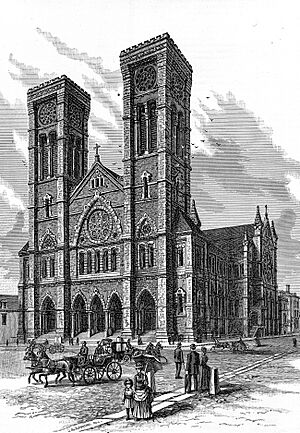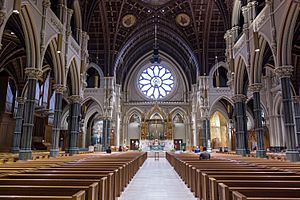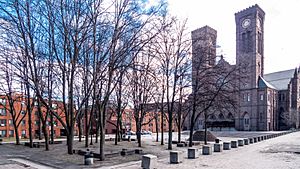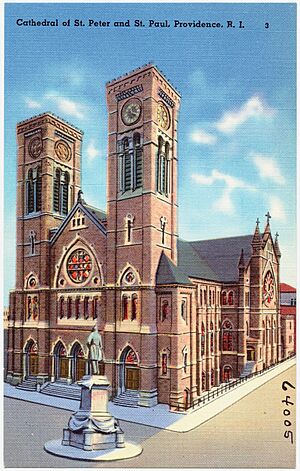Cathedral of Saints Peter and Paul (Providence, Rhode Island) facts for kids
Quick facts for kids Cathedral of Saints Peter and Paul |
|
|---|---|
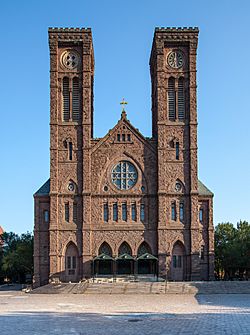 |
|
| Location | 30 Fenner Street Providence, Rhode Island |
| Country | United States |
| Denomination | Roman Catholic |
| History | |
| Status | Cathedral |
| Consecrated | June 30, 1889 |
| Architecture | |
| Functional status | Active |
| Architect(s) | Patrick C. Keely |
| Style | Romanesque Revival Gothic Revival |
| Groundbreaking | 1878 |
| Specifications | |
| Number of towers | 2 |
| Tower height | 156 feet (48 m) |
| Bells | 4 |
| Administration | |
| Diocese | Providence |
| Province | Hartford |
The Cathedral of Saints Peter and Paul is a large Roman Catholic church in Providence, Rhode Island. It is the main church for the Diocese of Providence. This beautiful church was designed in 1873 by Patrick Keely. It was added to the National Register of Historic Places in 1975.
History of the Cathedral
In 1838, the first Mass was held in a small church named Sts. Peter and Paul. More and more Catholic people moved to the area. By 1844, a new church area, called a diocese, was created. Its main office was in Hartford, Connecticut. But the bishop, William Tyler, chose to live in Providence. This was because most Catholics lived there. The small church soon became too crowded for all the new Irish Catholic immigrants.
By 1872, the Catholic population in the diocese grew to 200,000 people. Bishop Francis Patrick McFarland wanted to build a new, bigger cathedral. But he couldn't get enough support. In 1871, he asked the Pope for a smaller area to manage due to his health. So, Pope Pius IX created the Diocese of Providence. This new diocese included Rhode Island and parts of Massachusetts.
In April 1872, Father Thomas Francis Hendricken became the first bishop of the new Diocese of Providence. At that time, the diocese had 125,000 Catholics. It also had 43 churches, 53 priests, and many schools.
Building the New Cathedral
Like the bishop before him, Bishop Hendricken also wanted a new cathedral. The old church was too small and falling apart. First, the church had to pay off a $16,000 debt. Bishop Hendricken worked very hard to raise money. By 1872, the debt was paid, and planning for the new church began.
In 1873, Patrick Keely was chosen to design the church. He was known for designing many churches. The next year, work started on a temporary church. The old house for the priest was torn down. A new one was built where it still stands today.
The first stone of the current cathedral was laid in 1878. Bishop Hendricken saved $10,000 each year for the building. He also held many fundraisers. He only allowed work to continue if money was available. By 1882, the roof was finished, and work began inside.
Sadly, Bishop Hendricken's health got worse that year. He passed away before the cathedral was finished. His funeral was the first Mass held in the unfinished cathedral in 1886. At the time of his death, the building had cost $300,000. On June 30, 1889, the completed cathedral was officially opened by Bishop Matthew Harkins.
Later Changes
After almost 80 years, the cathedral had a big renovation starting in 1968. Leaders wanted to finish the work by 1972. This was for the 100th anniversary of the diocese. Bishop Russell J. McVinney started the work. But like Bishop Hendricken, he also passed away before it was done in 1971.
In 2006, the basement of the cathedral was updated. This area is used for church gatherings. The old burial place in the basement was moved. Bishop Hendricken's remains were moved to a new stone tomb in the main church. This was done because he was so important to the cathedral's history. Other bishops buried there were moved to a cemetery in Cranston.
Important Services Held Here
The first funeral Mass in the cathedral was on June 16, 1886. This was even before the building was finished. It was for Bishop Thomas Francis Hendricken. He had worked so hard to get the cathedral built.
On September 8, 1947, Knut Ansgar Nelson became a bishop here. He was a monk from Portsmouth Priory.
On September 17, 2001, a special memorial Mass was held. It was for Rhode Island native David Angell and his wife. They were on American Airlines Flight 11 on September 11, 2001. David Angell was a TV writer for shows like Cheers and Frasier. His brother, Bishop Kenneth Angell, led the Mass.
A funeral Mass for former Providence mayor Buddy Cianci was held on February 8, 2016. Bishop Thomas Joseph Tobin led this service.
Inside the Cathedral
The inside of the cathedral looks like a Gothic Revival style. It has a similar look to Holy Name Cathedral in Chicago. The outside is made of brownstone. It looks a lot like the old Cathedral of St. Joseph in Hartford, CT. Patrick Keely designed all three of these churches.
The tabernacle is a special box where the Eucharist is kept. It was made of bronze in Spain. The main altar is made of green marble from the French Alps. Green marble is also used on the walls and columns inside. The ceiling has carved wood arches. The spaces between the arches are painted with different scenes.
The Stained glass windows show stories from the Bible. They were made in Austria. A large stone tomb is in the west part of the church. It holds the remains of Bishop Thomas Francis Hendricken.
Outside the Cathedral
The building is made of Connecticut Brownstone. It is one of the most famous buildings in Providence. It has two towers that are 156 feet tall. These towers hold four church bells. The bells are named after the Four Evangelists: Matthew, Mark, Luke, and John. They were made in a Dutch factory. Bishop McVinney dedicated them in 1968.
Cathedral Square
Cathedral Square is an open public space in front of the cathedral. From 1878 until World War II, this square was a busy part of downtown Providence. There were shops and businesses, and many people gathered there. After the war, people moved to the suburbs. The square became less busy.
In the late 1960s, the city hired a famous architect, I. M. Pei. He was asked to redesign Cathedral Square. His new design, like old Greek marketplaces, opened in 1972. But the city ran out of money. So, Pei's full plan was never finished. Also, new buildings and the highway Interstate 95 changed the area. By 2016, people called the square a "hidden gem" that was often forgotten.
Doyle Statue
A statue of Providence mayor Thomas A. Doyle was put in Cathedral Square in 1889. It was moved to a different street corner in 1967.
The Organ
The large organ in the cathedral was built by the Casavant Frères company in Quebec, Canada. It was finished in July 1971. A famous organ builder, Lawrence Phelps, designed it. The organ cost $217,500. It has four keyboards and a pedalboard. It has 74 stops and 126 ranks. There are 6,616 pipes! These pipes range from 6 inches to 32 feet long. This is one of the biggest organs in North America. It is also one of the largest ever built by Casavant Frères.
Images for kids
See also
 In Spanish: Catedral de los Santos Pedro y Pablo (Providence) para niños
In Spanish: Catedral de los Santos Pedro y Pablo (Providence) para niños


